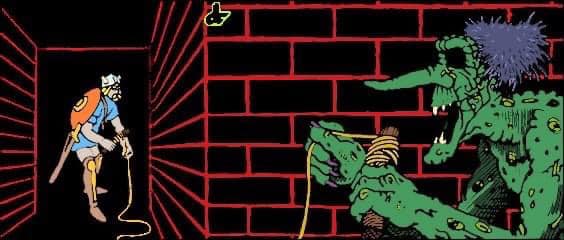

| Encumbrance | Silent Movement | Invisible Movement | Movement (DSG) | Movement (WSG) |
| Movement in the Dungeon | Movement Outdoors | Movement in the Cities | Note | PH |

Movement rate is always shown
by a numeral followed by the sign for inches thus, 9".
The number of inches moved
is scaled to circumstances and time by modifying either the distance
represented or the time period
or both.
Movement in the Dungeon:
The movement distance in
the dungeon is 1" to 10' over a TURN of 10 minutes duration while exploration
&& mapping are in progress.
* If the party is following a known route or map, the movement rate is 5 times greater, so each move takes 1/5 of a turn (2 rounds).
* If the party is fleeing, all movement -- excluding encumbered movement, is 10 times faster, so each move takes only 1/10 of a turn, or 1 round.
* This same movement rate
applies to combat situations, so by converting each 1" movement rate to
10',
and then taking 1/10 of
the round (using segments), the distance a character or monster can travel
during the course of combat
is easily found:
| Movement Rate | Round (1 minute) | Segment (6 seconds) |
| 6" | 60' | 6' |
| 9" | 90' | 9' |
| 12" | 120' | 12' |
| 15" | 150' | 15' |
| 18" | 180' | 18' |
If moving but 12' in 6 seconds
seems slow, consider the conditions --
whether prolonged physical
exertion or the threat of hostile counter to the movement.
Movement Outdoors:
The major difference in outdoor movement is distance and time.
Each 1" equals the number
of miles a character or creature can travel in one-half day's trekking.
Terrain will vary the movement
rate.
When an encounter occurs,
the movement rate is handled in the same manner as combat movement
in the dungeon.
Movement in Cities:
When your party is in an inhabited AREA, movement turns are at the same
rate as when combat in the dungeon takes place,
i.e. 6" = 60' and each move
is 1 minute long.
This assumes that no map
is being made.
Mapping takes 10 times as
long, so movement whenmapping is the same as in a dungeon.
Note:
No mapping is possible when a party is moving at FAST SPEED such as when
pursued or pursuing.
Light
must be available to make or read a map;
infravision is not suitable
in such circumstances.
Marks, dropped objects,
or a trailing string or line are typically useless devices in dungeons,
as they will be obliterated, moved,
or destroyed by passing
creatures.